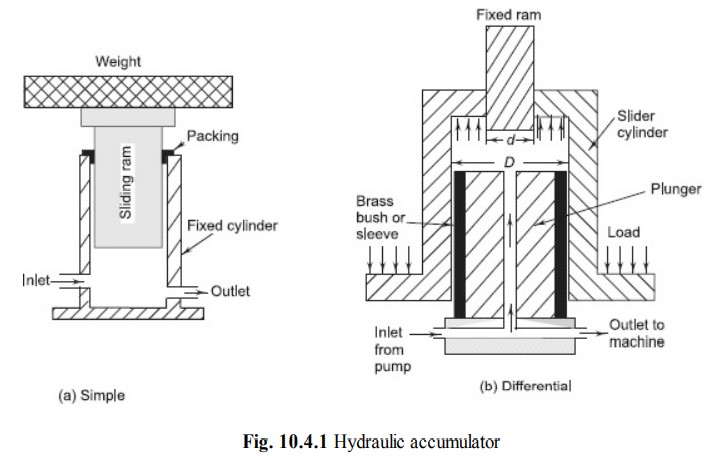Question 10.4.1: The total weight including the self-weight of ram placed on ......
The total weight including the self-weight of ram placed on the sliding ram of a hydraulic accumulator is 40 kN. The diameter of the ram is 500 mm. If the frictional resistance against the movement of the ram is 5% of the total weight, determine the intensity of pressure of water when (i) the ram is moving up with a uniform speed, and (ii) the ram is moving down with uniform speed. If the stroke of the ram is 10 m and the ram falls through the full stroke in 4 min steadily, find the work done by the accumulator per second. If the pump, connected to the inlet of the accumulator, supplies 0.01 m³/s at the same time, determine the work supplied by the pump per second and also the power delivered by the accumulator to the hydraulic machine, connected at the outlet of the hydraulic accumulator, when ram is moving downwards.
Learn more on how do we answer questions.
Given: W = 40 kN, D = 0.5 m → A = 0.1963 m², frictional resistance FR = 0.05 × 40000 = 2000 N, t = time taken to travel 10 m = 240 s, stroke L = 10 m, Q = 0.01 m³/s.
See Fig. 10.4.1 (a).
When ram moves up then the force required, F = weight + FR = 42000 N
∴ p, intensity of pressure = 42000/0.1963 = 214 kN/m²
When ram moves down then the force required F = weight – FR = 38000 N
∴ p = intensity of pressure, 38000/0.1963 = 193.581 kN/m²
Discharge from the accumulator, q = A × L/t = 0.1963 × 10/240 = 0.00818 m³/s
Work done by accumulator/s = 38000 × 10/240 = 1583.33 W
pressure head of the pump during working stroke, H = 193.581/w = 19.733 m
Work done by pump= w Q H = 9810 × 0.01 × 19.733 = 1935.81 W
Total work delivered to the machine = 1583.33 + 1935.81 = 3519 W or 3.519 kW
